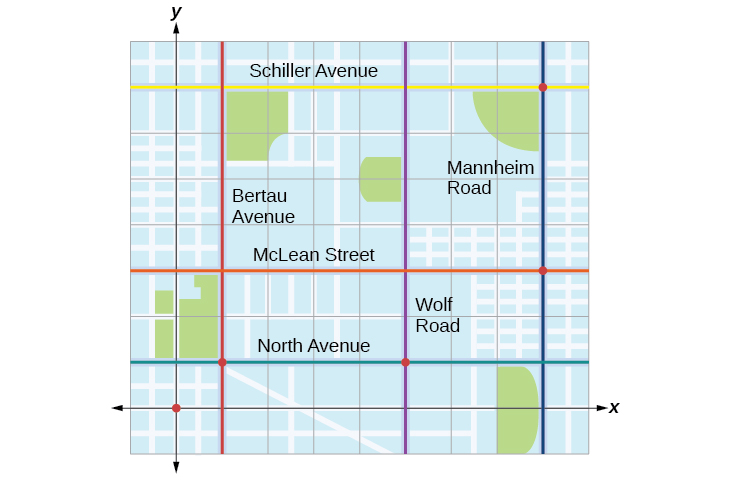
In this section you will:
-intercepts and
-intercepts.

Tracie set out from Elmhurst, IL, to go to Franklin Park. On the way, she made a few stops to do errands. Each stop is indicated by a red dot in [link]. Laying a rectangular coordinate grid over the map, we can see that each stop aligns with an intersection of grid lines. In this section, we will learn how to use grid lines to describe locations and changes in locations.
An old story describes how seventeenth-century philosopher/mathematician René Descartes invented the system that has become the foundation of algebra while sick in bed. According to the story, Descartes was staring at a fly crawling on the ceiling when he realized that he could describe the fly’s location in relation to the perpendicular lines formed by the adjacent walls of his room. He viewed the perpendicular lines as horizontal and vertical axes. Further, by dividing each axis into equal unit lengths, Descartes saw that it was possible to locate any object in a two-dimensional plane using just two numbers—the displacement from the horizontal axis and the displacement from the vertical axis.
While there is evidence that ideas similar to Descartes’ grid system existed centuries earlier, it was Descartes who introduced the components that comprise the Cartesian coordinate system, a grid system having perpendicular axes. Descartes named the horizontal axis the x-axis and the vertical axis the y-axis.
The Cartesian coordinate system, also called the rectangular coordinate system, is based on a two-dimensional plane consisting of the x-axis and the y-axis. Perpendicular to each other, the axes divide the plane into four sections. Each section is called a quadrant; the quadrants are numbered counterclockwise as shown in [link]
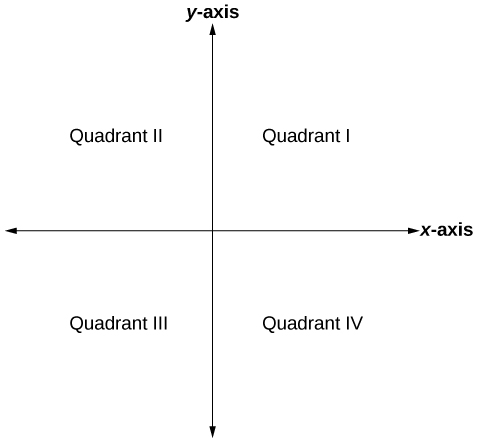
The center of the plane is the point at which the two axes cross. It is known as the origin, or point
From the origin, each axis is further divided into equal units: increasing, positive numbers to the right on the x-axis and up the y-axis; decreasing, negative numbers to the left on the x-axis and down the y-axis. The axes extend to positive and negative infinity as shown by the arrowheads in [link].
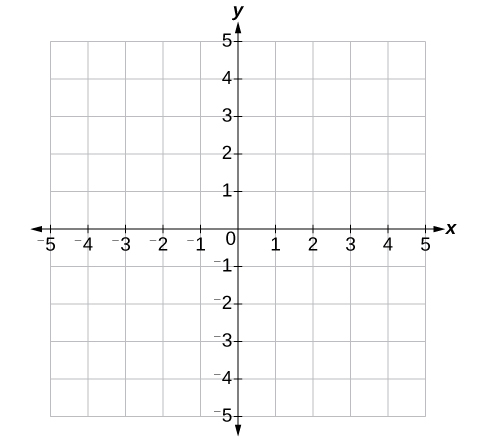
Each point in the plane is identified by its x-coordinate, or horizontal displacement from the origin, and its y-coordinate, or vertical displacement from the origin. Together, we write them as an ordered pair indicating the combined distance from the origin in the form
An ordered pair is also known as a coordinate pair because it consists of x- and y-coordinates. For example, we can represent the point
in the plane by moving three units to the right of the origin in the horizontal direction, and one unit down in the vertical direction. See [link].
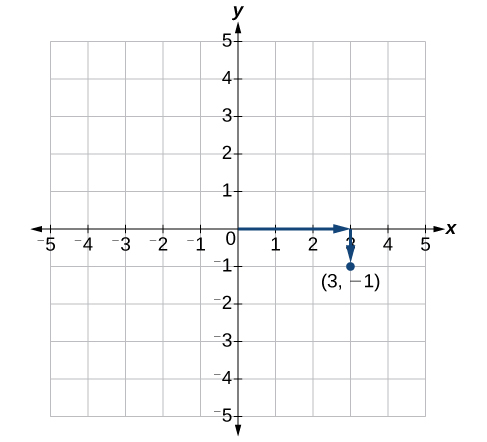
When dividing the axes into equally spaced increments, note that the x-axis may be considered separately from the y-axis. In other words, while the x-axis may be divided and labeled according to consecutive integers, the y-axis may be divided and labeled by increments of 2, or 10, or 100. In fact, the axes may represent other units, such as years against the balance in a savings account, or quantity against cost, and so on. Consider the rectangular coordinate system primarily as a method for showing the relationship between two quantities.
A two-dimensional plane where the
A point in the plane is defined as an ordered pair,
such that x is determined by its horizontal distance from the origin and y is determined by its vertical distance from the origin.
Plot the points
and
in the plane.
To plot the point
begin at the origin. The x-coordinate is –2, so move two units to the left. The y-coordinate is 4, so then move four units up in the positive y direction.
To plot the point
begin again at the origin. The x-coordinate is 3, so move three units to the right. The y-coordinate is also 3, so move three units up in the positive y direction.
To plot the point
begin again at the origin. The x-coordinate is 0. This tells us not to move in either direction along the x-axis. The y-coordinate is –3, so move three units down in the negative y direction. See the graph in [link].
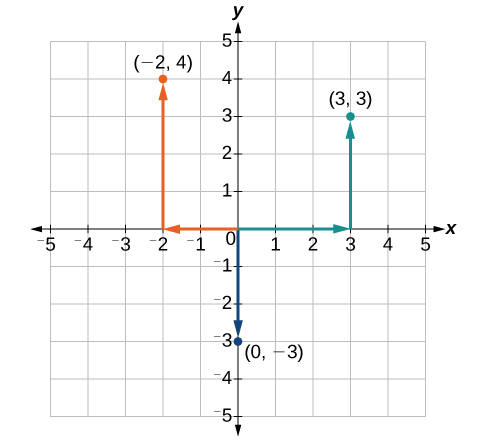
Note that when either coordinate is zero, the point must be on an axis. If the x-coordinate is zero, the point is on the y-axis. If the y-coordinate is zero, the point is on the x-axis.
We can plot a set of points to represent an equation. When such an equation contains both an x variable and a y variable, it is called an equation in two variables. Its graph is called a graph in two variables. Any graph on a two-dimensional plane is a graph in two variables.
Suppose we want to graph the equation
We can begin by substituting a value for x into the equation and determining the resulting value of y. Each pair of x- and y-values is an ordered pair that can be plotted. [link] lists values of x from –3 to 3 and the resulting values for y.
We can plot the points in the table. The points for this particular equation form a line, so we can connect them. See [link]. This is not true for all equations.

Note that the x-values chosen are arbitrary, regardless of the type of equation we are graphing. Of course, some situations may require particular values of x to be plotted in order to see a particular result. Otherwise, it is logical to choose values that can be calculated easily, and it is always a good idea to choose values that are both negative and positive. There is no rule dictating how many points to plot, although we need at least two to graph a line. Keep in mind, however, that the more points we plot, the more accurately we can sketch the graph.
Given an equation, graph by plotting points.
Construct a table and graph the equation by plotting points:
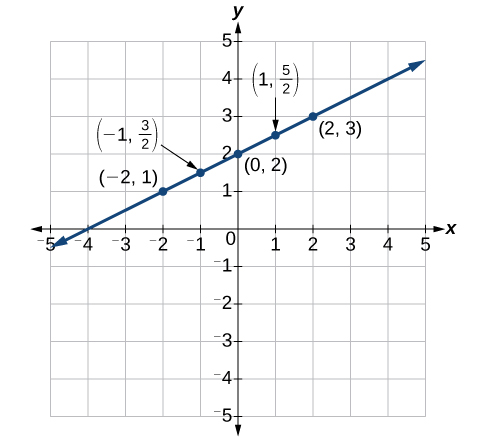
Most graphing calculators require similar techniques to graph an equation. The equations sometimes have to be manipulated so they are written in the style
The TI-84 Plus, and many other calculator makes and models, have a mode function, which allows the window (the screen for viewing the graph) to be altered so the pertinent parts of a graph can be seen.
For example, the equation
has been entered in the TI-84 Plus shown in [link]a. In [link]b, the resulting graph is shown. Notice that we cannot see on the screen where the graph crosses the axes. The standard window screen on the TI-84 Plus shows
and
See [link]c.

By changing the window to show more of the positive x-axis and more of the negative y-axis, we have a much better view of the graph and the x- and y-intercepts. See [link]a and [link]b.
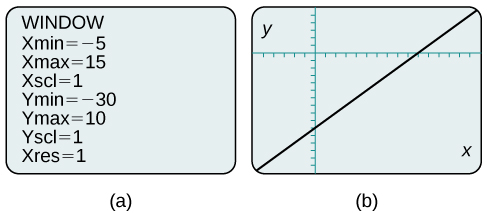
Use a graphing utility to graph the equation:
Enter the equation in the y= function of the calculator. Set the window settings so that both the x- and y- intercepts are showing in the window. See [link].
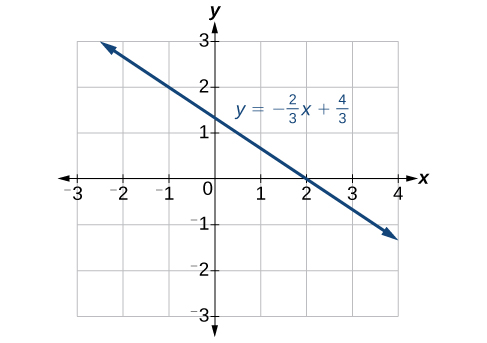
The intercepts of a graph are points at which the graph crosses the axes. The x-intercept is the point at which the graph crosses the x-axis. At this point, the y-coordinate is zero. The y-intercept is the point at which the graph crosses the y-axis. At this point, the x-coordinate is zero.
To determine the x-intercept, we set y equal to zero and solve for x. Similarly, to determine the y-intercept, we set x equal to zero and solve for y. For example, lets find the intercepts of the equation
To find the x-intercept, set
To find the y-intercept, set
We can confirm that our results make sense by observing a graph of the equation as in [link]. Notice that the graph crosses the axes where we predicted it would.

and solving for
and solving for
Find the intercepts of the equation
Then sketch the graph using only the intercepts.
Set
to find the x-intercept.
Set
to find the y-intercept.
Plot both points, and draw a line passing through them as in [link].
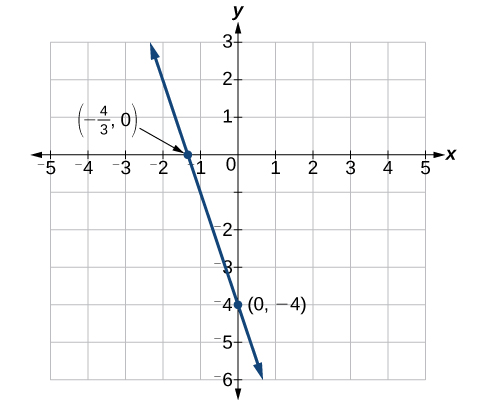
Find the intercepts of the equation and sketch the graph:
x-intercept is
y-intercept is

Derived from the Pythagorean Theorem, the distance formula is used to find the distance between two points in the plane. The Pythagorean Theorem,
is based on a right triangle where a and b are the lengths of the legs adjacent to the right angle, and c is the length of the hypotenuse. See [link].

The relationship of sides
and
to side d is the same as that of sides a and b to side c. We use the absolute value symbol to indicate that the length is a positive number because the absolute value of any number is positive. (For example,
) The symbols
and
indicate that the lengths of the sides of the triangle are positive. To find the length c, take the square root of both sides of the Pythagorean Theorem.
It follows that the distance formula is given as
We do not have to use the absolute value symbols in this definition because any number squared is positive.
Given endpoints
and
the distance between two points is given by
Find the distance between the points
and
Let us first look at the graph of the two points. Connect the points to form a right triangle as in [link].
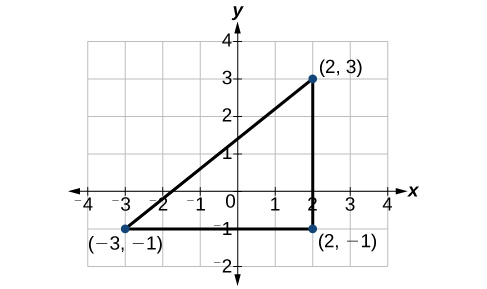
Then, calculate the length of d using the distance formula.
Find the distance between two points:
and
Let’s return to the situation introduced at the beginning of this section.
Tracie set out from Elmhurst, IL, to go to Franklin Park. On the way, she made a few stops to do errands. Each stop is indicated by a red dot in [link]. Find the total distance that Tracie traveled. Compare this with the distance between her starting and final positions.
The first thing we should do is identify ordered pairs to describe each position. If we set the starting position at the origin, we can identify each of the other points by counting units east (right) and north (up) on the grid. For example, the first stop is 1 block east and 1 block north, so it is at
The next stop is 5 blocks to the east, so it is at
After that, she traveled 3 blocks east and 2 blocks north to
Lastly, she traveled 4 blocks north to
We can label these points on the grid as in [link].
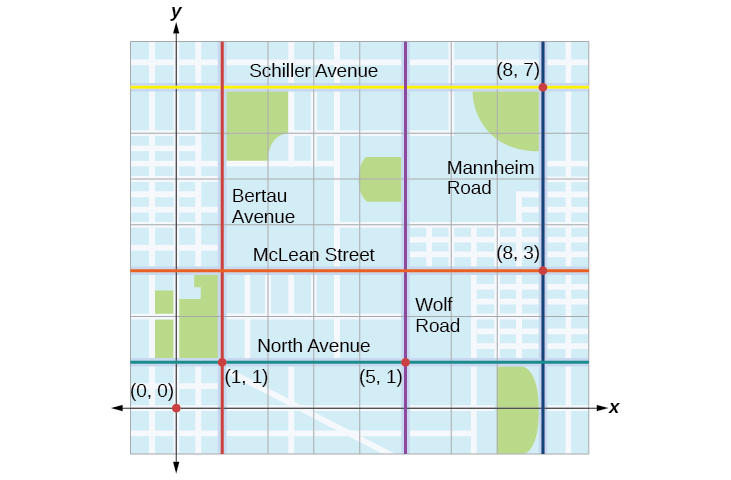
Next, we can calculate the distance. Note that each grid unit represents 1,000 feet.
Tracie might have driven north 1,000 feet and then east 1,000 feet, or vice versa. Either way, she drove 2,000 feet to her first stop.
So from
to
Tracie drove east 4,000 feet.
There are a number of routes from
to
Whatever route Tracie decided to use, the distance is the same, as there are no angular streets between the two points. Let’s say she drove east 3,000 feet and then north 2,000 feet for a total of 5,000 feet.
This is a straight drive north from
for a total of 4,000 feet.
Next, we will add the distances listed in [link].
| From/To | Number of Feet Driven |
|---|---|
to
| 2,000 |
to
| 4,000 |
to
| 5,000 |
to
| 4,000 | |
| Total | 15,000 |
The total distance Tracie drove is 15,000 feet, or 2.84 miles. This is not, however, the actual distance between her starting and ending positions. To find this distance, we can use the distance formula between the points
and
At 1,000 feet per grid unit, the distance between Elmhurst, IL, to Franklin Park is 10,630.14 feet, or 2.01 miles. The distance formula results in a shorter calculation because it is based on the hypotenuse of a right triangle, a straight diagonal from the origin to the point
Perhaps you have heard the saying “as the crow flies,” which means the shortest distance between two points because a crow can fly in a straight line even though a person on the ground has to travel a longer distance on existing roadways.
When the endpoints of a line segment are known, we can find the point midway between them. This point is known as the midpoint and the formula is known as the midpoint formula. Given the endpoints of a line segment,
and
the midpoint formula states how to find the coordinates of the midpoint
A graphical view of a midpoint is shown in [link]. Notice that the line segments on either side of the midpoint are congruent.
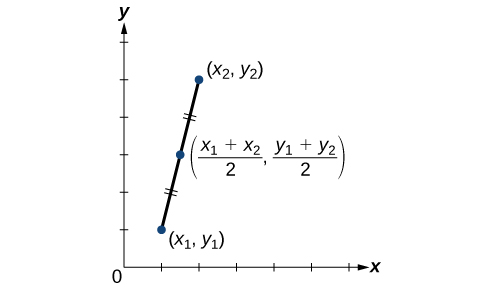
Find the midpoint of the line segment with the endpoints
and
Use the formula to find the midpoint of the line segment.
Find the midpoint of the line segment with endpoints
and
The diameter of a circle has endpoints
and
Find the center of the circle.
The center of a circle is the center, or midpoint, of its diameter. Thus, the midpoint formula will yield the center point.
Access these online resources for additional instruction and practice with the Cartesian coordinate system.
Is it possible for a point plotted in the Cartesian coordinate system to not lie in one of the four quadrants? Explain.
Answers may vary. Yes. It is possible for a point to be on the x-axis or on the y-axis and therefore is considered to NOT be in one of the quadrants.
Describe the process for finding the x-intercept and the y-intercept of a graph algebraically.
Describe in your own words what the y-intercept of a graph is.
The y-intercept is the point where the graph crosses the y-axis.
When using the distance formula
explain the correct order of operations that are to be performed to obtain the correct answer.
For each of the following exercises, find the x-intercept and the y-intercept without graphing. Write the coordinates of each intercept.
The x-intercept is
and the y-intercept is
The x-intercept is
and the y-intercept is
The x-intercept is
and the y-intercept is
For each of the following exercises, solve the equation for y in terms of x.
For each of the following exercises, find the distance between the two points. Simplify your answers, and write the exact answer in simplest radical form for irrational answers.
and
and
and
and
Find the distance between the two points given using your calculator, and round your answer to the nearest hundredth.
and
For each of the following exercises, find the coordinates of the midpoint of the line segment that joins the two given points.
and
and
and
and
and
For each of the following exercises, identify the information requested.
What are the coordinates of the origin?
If a point is located on the y-axis, what is the x-coordinate?
If a point is located on the x-axis, what is the y-coordinate?
For each of the following exercises, plot the three points on the given coordinate plane. State whether the three points you plotted appear to be collinear (on the same line).
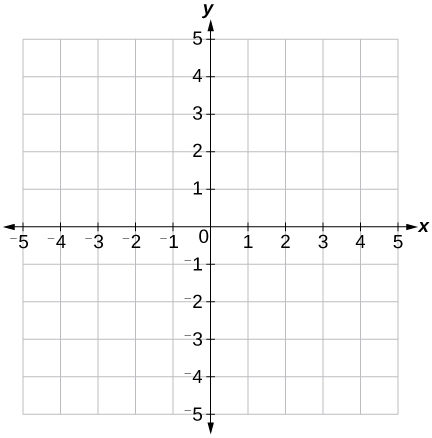

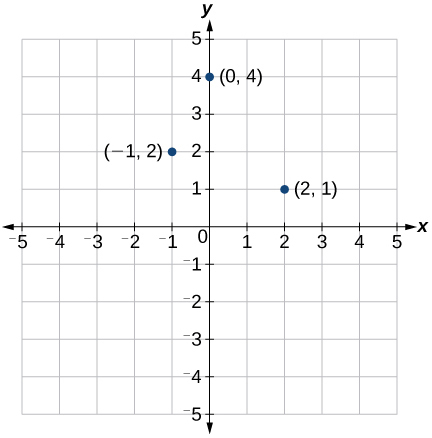 not collinear
not collinear

Name the coordinates of the points graphed.
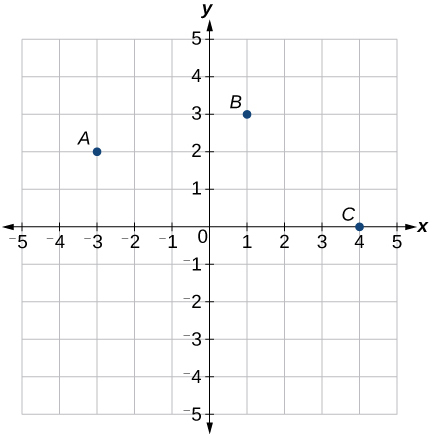
Name the quadrant in which the following points would be located. If the point is on an axis, name the axis.
For each of the following exercises, construct a table and graph the equation by plotting at least three points.
| 1 | |
| 0 | 2 |
| 3 | 3 |
| 6 | 4 |
| x | y |
| –3 | 0 |
| 0 | 1.5 |
| 3 | 3 |
For each of the following exercises, find and plot the x- and y-intercepts, and graph the straight line based on those two points.
For each of the following exercises, use the graph in the figure below.
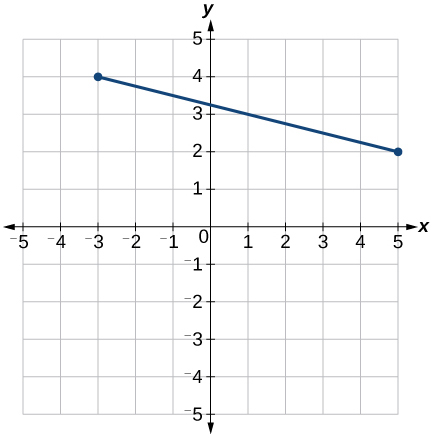 <div data-type="exercise">
<div data-type="exercise">
Find the distance between the two endpoints using the distance formula. Round to three decimal places.
</div>
Find the coordinates of the midpoint of the line segment connecting the two points.
Find the distance that
is from the origin.
Find the distance that
is from the origin. Round to three decimal places.
Which point is closer to the origin?
For the following exercises, use your graphing calculator to input the linear graphs in the Y= graph menu.
After graphing it, use the 2nd CALC button and 1:value button, hit enter. At the lower part of the screen you will see “x=” and a blinking cursor. You may enter any number for x and it will display the y value for any x value you input. Use this and plug in x = 0, thus finding the y-intercept, for each of the following graphs.
For the following exercises, use your graphing calculator to input the linear graphs in the Y= graph menu.
After graphing it, use the 2nd CALC button and 2:zero button, hit enter. At the lower part of the screen you will see “left bound?” and a blinking cursor on the graph of the line. Move this cursor to the left of the x-intercept, hit ENTER. Now it says “right bound?” Move the cursor to the right of the x-intercept, hit enter. Now it says “guess?” Move your cursor to the left somewhere in between the left and right bound near the x-intercept. Hit enter. At the bottom of your screen it will display the coordinates of the x-intercept or the “zero” to the y-value. Use this to find the x-intercept.
Note: With linear/straight line functions the zero is not really a “guess,” but it is necessary to enter a “guess” so it will search and find the exact x-intercept between your right and left boundaries. With other types of functions (more than one x-intercept), they may be irrational numbers so “guess” is more appropriate to give it the correct limits to find a very close approximation between the left and right boundaries.
Round your answer to the nearest thousandth.
A man drove 10 mi directly east from his home, made a left turn at an intersection, and then traveled 5 mi north to his place of work. If a road was made directly from his home to his place of work, what would its distance be to the nearest tenth of a mile?
If the road was made in the previous exercise, how much shorter would the man’s one-way trip be every day?
mi shorter
Given these four points:
find the coordinates of the midpoint of line segments
and
After finding the two midpoints in the previous exercise, find the distance between the two midpoints to the nearest thousandth.
Given the graph of the rectangle shown and the coordinates of its vertices, prove that the diagonals of the rectangle are of equal length.
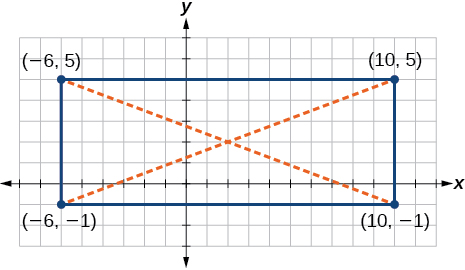
In the previous exercise, find the coordinates of the midpoint for each diagonal.
Midpoint of each diagonal is the same point
Note this is a characteristic of rectangles, but not other quadrilaterals.
The coordinates on a map for San Francisco are
and those for Sacramento are
Note that coordinates represent miles. Find the distance between the cities to the nearest mile.
If San Jose’s coordinates are
where the coordinates represent miles, find the distance between San Jose and San Francisco to the nearest mile.
mi
A small craft in Lake Ontario sends out a distress signal. The coordinates of the boat in trouble were
One rescue boat is at the coordinates
and a second Coast Guard craft is at coordinates
Assuming both rescue craft travel at the same rate, which one would get to the distressed boat the fastest?
A man on the top of a building wants to have a guy wire extend to a point on the ground 20 ft from the building. To the nearest foot, how long will the wire have to be if the building is 50 ft tall?
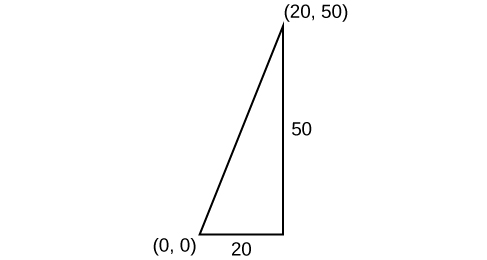
54 ft
If we rent a truck and pay a $75/day fee plus $.20 for every mile we travel, write a linear equation that would express the total cost
using
to represent the number of miles we travel. Graph this function on your graphing calculator and find the total cost for one day if we travel 70 mi.

You can also download for free at http://cnx.org/contents/13ac107a-f15f-49d2-97e8-60ab2e3b519c@11.1
Attribution: